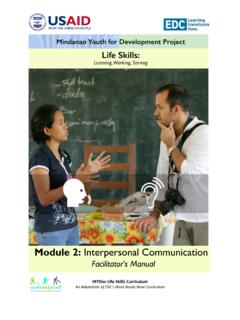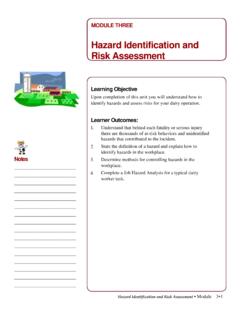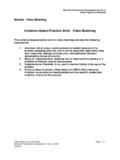Transcription of Learner’s Guide - Crisis Prevention Institue
1 DRAFT nonviolent Crisis interventionLearner sGuideNONVIOLENT Crisis INTERVENTION FOUNDATION COURSE17-FLX-LGD-0221 04/17 Flex Learner s Guide :: 2 2017 Learner s GuideWelcome to Nonviolent Crisis Intervention Flex training! The purpose of this Guide is to get the most out of your learning experience and prepare you for the classroom portion of training. You will complete personal reflections, examples, and stories that you will be asked to share during the in-class portion of training. Think about your organization and how you will begin to apply the concepts learned in this program. Print the Guide and bring it to the classroom portion of your training. You will use this to share examples and take notes in class. You may also type directly into the document to save notes and then print. This document is a interactive PDF.
2 When you open it in Adobe Acrobat, click on Tools, and Edit. Write your notes by typing in the text boxes provided. Flex Learner s Guide :: 3 2017 1: The CPI Crisis Development ModelSMBy learning this model you ll be able to identify behaviors and respond to and/or de-escalate the behavior to re-establish Therapeutic Rapport. Crisis Development/Behavior LevelsStaff Attitudes/Approaches1. 1. 2. 2. 3. 3. 4. 4. 1. How do you apply Care, Welfare, Safety, and SecuritySM in your organization?2. Write an example of a behavior from your workplace that will fall into each of the four behavior levels and how you would respond. 3. Consider the Crisis Development ModelSM and Integrated Experience; what did you learn about recognizing behaviors or a staff response that you can apply to your work right away?
3 Notes: Flex Learner s Guide :: 4 2017 2: Nonverbal CommunicationBy being aware of your nonverbal communication, along with your position, posture, and proximity (Supportive StanceSM), you ll be able to change your approaches to have an effect on the behavior level of an individual. 1. What are some ways you can improve your own nonverbal communication ( , gestures, stance, use of touch, etc.)?2. List two examples of how the concepts from this unit (proxemics, kinesics, haptics) apply in the work you What are other factors and realities that may impact your nonverbal communication and how you use it in your work?Notes: Flex Learner s Guide :: 5 2017 3: Paraverbal and Verbal CommunicationBy being aware of your verbal and paraverbal communication, you will learn that the sound of your words is equally, if not more, important than the words you use to de-escalate a Crisis How will you adjust elements of your verbal and paraverbal communication when working with someone who is escalating in behavior?
4 2. Give two examples of how paraverbal communication can contribute to misinterpretation of What are specific circumstances or environmental situations where you work in which the components of paraverbal communication will be especially important?Notes: Flex Learner s Guide :: 6 2017 4: Verbal InterventionBy learning the Verbal Escalation ContinuumSM, you ll be able to verbally respond to Defensive behavior through Directive approaches. You may encounter defensive behaviors in any combination or order. 1. How are you effectively using verbal intervention skills today to intervene when a person displays defensive behavior?2. Give an example of defensive behavior you have experienced with a person in your care and categorize it based on the Verbal Escalation ContinuumSM ( , questioning, refusal, release, etc.)
5 3. In a few words, describe how an individual in your care may refuse a directive. Then write out how you might set limits to encourage this individual to make a better :Defensive Flex Learner s Guide :: 7 2017 5: Precipitating Factors, Rational Detachment, Integrated ExperienceRecognizing Precipitating Factors and how to rationally detach minimizes personal conflicts and maintains professionalism. When talking about the Integrated Experience, you recognize that your behavior has an impact on those in your care and vice How well have you been able to recognize Precipitating Factors during interactions with people in your care, and are you able to depersonalize Crisis situations?2. What are some ways you can rationally detach to maintain your professionalism?3. What are some examples of Integrated Experiences that you have encountered that either escalated or de-escalated a Crisis situation?
6 Notes: Flex Learner s Guide :: 8 2017 6: Staff Fear and AnxietyLearn how to make the productive behaviors caused by fear work for you in a Crisis What are some conditions that may trigger your unproductive responses to fear or anxiety?2. List two examples of productive responses to fear and two examples of unproductive responses to fear you may have Considering the situations you and other staff may encounter with challenging behaviors, what do you think is important in maximizing productive responses?Notes: Flex Learner s Guide :: 9 2017 7: Decision MakingKnowing how to assess the appropriate level of risk in a Crisis situation will help you make better decisions on how to best respond and prevent crises from reoccurring. 1. How comfortable are you in making decisions that impact intervening in a Crisis situation?
7 What are some behaviors that you find easy or difficult to assess?2. Provide an example of when you successfully assessed the likelihood and severity of a How might you use the Decision-Making Matrix in your organization? Where do you find this tool useful to mitigate risk?Notes:Higher RiskLower Risk Flex Learner s Guide :: 10 2017 8: Physical Interventions Disengagement SkillsThere are no personal reflections or examples for Modules 8 and 9. Your facilitator will Guide your discussion on these sections in the the various frameworks and tools to be considered when physically intervening in a Crisis situation. These concepts will be covered in more depth in the classroom portion of training. Notes: module 9: Physical Interventions Holding SkillsLearn the potential risks associated with holding skills and how to minimize the risks of restraints when intervening in a Crisis situation.
8 Consider the Opt-Out SequenceSM as a tool to reduce risks. These concepts will be covered in more depth in the classroom portion of : Flex Learner s Guide :: 11 2017 10: PostventionEach letter in the COPING ModelSM stands for a word that describes how to establish Therapeutic Rapport with an individual in Tension Reduction or with staff as a debriefing process. 1. What are some ways you recognize Tension Reduction in an individual?2. Write an example of when you provided Therapeutic Rapport that led to a positive Consider using the COPING ModelSM as a tool for learning, growth, and change. What can you do immediately in your workplace to improve your debriefing or communication with individuals in your care?Notes.















